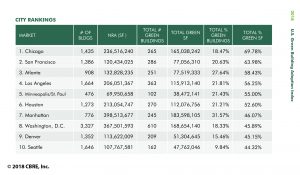DENVER – According to the annual U.S. Green Building Adoption Index by CBRE and Maastricht University, 45.2 percent of Denver office space is green certified, up from 41.9 percent last year. However the increase was not enough to hold Denver’s place in the rankings. The Mile High City fell two spots on this year’s list, coming in at No. 9, trailing behind cities seeing faster green adoption like Manhattan and Washington, D.C.
 “Green” office buildings in the U.S. are defined as those that hold either an EPA ENERGY STAR® label, USGBC LEED certification or both. According to the report, 11.5 percent of all buildings surveyed are ENERGY STAR labeled, while 5.2 percent of buildings are LEED certified, both at all-time highs in the five-year study.
“Green” office buildings in the U.S. are defined as those that hold either an EPA ENERGY STAR® label, USGBC LEED certification or both. According to the report, 11.5 percent of all buildings surveyed are ENERGY STAR labeled, while 5.2 percent of buildings are LEED certified, both at all-time highs in the five-year study.
In Denver, 15.5 percent of buildings are green certified, up from 13.3 percent last year. The city achieved all-time highs in many categories including number of certified buildings (209), the percentage of buildings with an ENERGY STAR label (14.1 percent) and the total percentage of ENERGY STAR-labeled square footage (40.4 percent).
“It’s encouraging to see more Denver building owners pursue, achieve and maintain green certification. It’s another example of how commercial real estate investors are considering the entire spectrum of their strategy. It’s no longer just about cost, factors like sustainability and employee experience are playing a much bigger role in investment and operational decision making,” said Pete Schippits, senior managing director for CBRE in Colorado.
Chicago holds the top spot with nearly 70 percent of its space green certified. In addition to defending its title as the nation’s greenest city, Chicago saw a difference of nearly 6 percent with second-place San Francisco, the largest spread ever recorded in the Green Building Adoption Index. Atlanta maintained the third spot with more than 58 percent of all space green certified, while a surging Los Angeles claimed fourth – up from sixth last year. Minneapolis rounds out the top five with 55 percent of office space certified.
Continued improvement in average energy efficiency for the nation’s commercial buildings also prompted the EPA to change the underlying calculations for ENERGY STAR scoring this year. This change is expected to lower average scores for office buildings by as much as 10 points next year. These changes may have a significant impact on next year’s Green Building Adoption Index rankings, particularly for markets whose ENERGY STAR certifications comprise the bulk of their green space.
“Green building certifications have become an important proxy for sustainable practices, recognized by all stakeholders. Any significant change to one of these major certification programs can have a significant impact on the buildings affected. We will be closely watching for the results,” said David Pogue, CBRE’s senior vice president, Global Client Care.
Green Buildings Certification Influencing Capital Markets CBRE and Maastricht University researchers note that building certification has become a more recognized and important part of a building’s profile. As these programs reach maturity, the capital markets are increasingly incorporating these certificates into loan pricing and alternative financial instruments such as green bonds. And, according to additional research by Green Building Adoption Index co-author Rogier Holtermans, buildings certified by ENERGY STAR and/or LEED have been shown to transact for about 10.1 percent more than non-green certified buildings.
“Obtaining a green building certification is more than a trend, it’s practically become the standard for a property to be considered a top-tier asset. A green certification is a signal that a building is either new construction or newly renovated to higher-than-normal standards, instilling confidence in fund managers, advisors and the investors they serve,” said Jenny Knowlton, vice president with CBRE Capital Markets in Denver.
View the study’s findings HERE.









